Impact of Ambient Temperature on Shunt Capacitor Placement in a Distorted Radial Distribution System
Abstract
1. Introduction
2. Problem Formulation
2.1. Load Flow
2.1.1. Fundamental Power Flow
2.1.2. Harmonic Power Flow
- Compute the magnitudes of the bus voltages and their phase angles at the fundamental frequency via the backward-forward sweep method.
- Compute the fundamental currents, harmonic currents, harmonic load admittances, admittances of the installed shunt capacitors, and the feeder admittances using Equations (3) to (7), respectively.
- Calculate the harmonic voltages caused by the nonlinear loads from Equation (8).
- Compute the RMS voltages and the Total Harmonic Distortion (THD) at each bus using Equations (11) and (12), respectively.
2.2. Constraints
- The bus voltages must be within their allowable minimum and maximum range limits:where, and
- The power flow () in each distribution line must be less than the maximum limit of power flow in this line ():
- The overall power factor () of the distribution system must be greater than or equal to the lower limit of power factor () of this system as:
- The total injected reactive power () into the distribution system must be less than or equal the total load reactive power () of this system:The standard capacitor size of 150 kVAR is used.
- The waveform distortion of the bus voltages is measured through the maximum total harmonic distortion of the bus voltages as
2.3. Ambient Temperature Modelling
- The IEEE 34-bus RDS has MW. The slope of increasing power consumption per one degree Celsius can be found by . The relationship between the power consumed by this system and the temperature is
- The SEC’s RDS has MW. The slope of increasing power consumption per one degree Celsius can be found by . The relationship between the power consumed by this system and the temperature is:where, is the power demand for each system; y is the power consumed in MW; and x is the temperature in degrees Celsius (25–45).
3. Fuzzy Expert System for Capacitor Placement
3.1. Methodology
3.2. Fuzzy Expert System Steps
4. Genetic Algorithm for Capacitor Sizing
4.1. Genetic Algorithm Search Space
4.2. Genetic Algorithm Operators
- Selection normalizes the survival of the fittest.
- Crossover refers to propagation between individuals.
- Mutation makes random alterations.
4.3. Genetic Algorithm Steps
- (1)
- Create a population at candidate buses with random capacitors sizes and set this as Gen= 1.
- (2)
- Use the backward-forward sweep algorithm as a load flow tool to determine the values of the bus voltages and power losses.
- (3)
- Calculate the fitness values of the objective functions.
- (4)
- Choose the parent strings using a roulette wheel selection mechanism.
- (5)
- Execute the crossover and mutation operations on the selected strings to get new strings for the generation of the next offspring.
- (6)
- Repeat steps 2 to 5 until the difference between the best fitness value of the objective function and the average fitness of all possible solutions is less than a specified error.
- (7)
- Print the best fitness of the objective function.
5. Results and Discussion
5.1. Simulation of the IEEE 34-Bus Radial Distribution Systems
5.2. Simulation of the 7151C-Bus RDS
5.3. Limitations
6. Conclusions
Author Contributions
Acknowledgments
Conflicts of Interest
Appendix A
| From Bus, i | To Bus, i + 1 | R i, i + 1 (Ω) | X I, I + 1 (Ω) | PL (kW) | QL (kVAR) |
|---|---|---|---|---|---|
| 1 | 2 | 0.804 | 1.16 | 116.2 | 56.3 |
| 2 | 3 | 0.2412 | 0.348 | 464.8 | 225.1 |
| 3 | 4 | 0.402 | 0.58 | 508.5 | 246.3 |
| 4 | 5 | 0.1206 | 0.174 | 290.5 | 140.7 |
| 5 | 6 | 0.1206 | 0.174 | 159.8 | 77.4 |
| 6 | 7 | 0.201 | 0.29 | 101.6 | 49.2 |
| 3 | 8 | 0.1206 | 0.174 | 125.8 | 60.9 |
| 4 | 9 | 0.1608 | 0.232 | 72.6 | 35.2 |
| 4 | 10 | 0.3216 | 0.464 | 48.4 | 23.5 |
| 4 | 11 | 0.402 | 0.580 | 14.5 | 7 |
| 9 | 12 | 0.0965 | 0.1392 | 87.1 | 42.2 |
| 9 | 13 | 0.0161 | 0.0232 | 0 | 0 |
| 13 | 14 | 0.2412 | 0.348 | 145.3 | 70.4 |
| 13 | 15 | 0.201 | 0.29 | 145.3 | 70.4 |
| 15 | 16 | 0.1608 | 0.232 | 14.5 | 7 |
| 16 | 17 | 0.1608 | 0.232 | 193.6 | 93.8 |
| 15 | 18 | 0.3216 | 0.464 | 96.8 | 46.9 |
References
- Rao, R.S.; Narasimham, S.; Ramalingaraju, M. Optimal capacitor placement in a radial distribution system using plant growth simulation algorithm. Int. J. Electr. Power Energy Syst. 2011, 33, 1133–1139. [Google Scholar] [CrossRef]
- Nojavan, S.; Jalali, M.; Zare, K. Optimal allocation of capacitors in radial/mesh distribution systems using mixed integer nonlinear programming approach. Electr. Power Syst. Res. 2014, 107, 119–124. [Google Scholar] [CrossRef]
- Su, C.-T.; Lii, G.-R.; Tsai, C.-C. Optimal capacitor allocation using fuzzy reasoning and genetic algorithms for distribution systems. Math. Comput. Model. 2001, 33, 745–757. [Google Scholar] [CrossRef]
- De Souza, B.A.; Alves, H.N.; Ferreira, H.A. Microgenetic algorithms and fuzzy logic applied to the optimal placement of capacitor banks in distribution networks. IEEE Trans. Power Syst. 2004, 19, 942–947. [Google Scholar] [CrossRef]
- Prasad, P.; Sivanagaraju, S.; Sreenivasulu, N. A fuzzy-genetic algorithm for optimal capacitor placement in radial distribution systems. ARPN J. Eng. Appl. Sci. 2007, 2, 28–32. [Google Scholar]
- Reddy, M.D.; Reddy, V. Optimal capacitor placement using fuzzy and real coded genetic algorithm for maximum savings. J. Theor. Appl. Inf. Technol. 2008, 4, 219–226. [Google Scholar]
- Sreenivasulu, A. Optimal Capacitor Placement for Loss Reduction in Distribution Systems Using Fuzzy and Hybrid Genetic Algorithm. Int. J. Eng. 2013, 2, 3182–3186. [Google Scholar]
- Hsiao, Y.-T.; Chen, C.-H.; Chien, C.-C. Optimal capacitor placement in distribution systems using a combination fuzzy-GA method. Int. J. Electr. Power Energy Syst. 2004, 26, 501–508. [Google Scholar] [CrossRef]
- Gampa, S.R.; Das, D. Optimum placement of shunt capacitors in a radial distribution system for substation power factor improvement using fuzzy GA method. Int. J. Electr. Power Energy Syst. 2016, 77, 314–326. [Google Scholar] [CrossRef]
- Venkatesh, B.; Ranjan, R. Fuzzy EP algorithm and dynamic data structure for optimal capacitor allocation in radial distribution systems. IEE Proc. Gener. Transm. Distrib. 2006, 153, 80–88. [Google Scholar] [CrossRef]
- Saranya, S.G.; Muthukumaran, E.; Kannan, S.M.; Kalyani, S. Optimal Capacitor Placement in Radial Distribution Feeders Using Fuzzy-Differential Evolution. In Proceedings of the 2011 National Conference on Innovations in Emerging Technology (NCOIET), Erode, India, 17–18 February 2011. [Google Scholar]
- Reddy, M.D.; Reddy, V.V. Capacitor placement using fuzzy and particle swarm optimization method for maximum annual savings. ARPN J. Eng. Appl. Sci. 2008, 3, 25–30. [Google Scholar]
- Murthy, K.R.; Raju, M.R.; Rao, G.G. Comparison of Index Vector & Fuzzy-PSO Methods with Respect to Optimal Capacitor Placement in Agricultural Distribution System. In Proceedings of the 16th National Power Systems Conference, Hyderabad, India, 15–17 December 2010. [Google Scholar]
- Isac, S.J.; Kumar, K.S.; Kumar, P.V. Optimal Capacitor Placement in Radial Distribution System to Minimize the Loss Using Fuzzy Logic Control. In Proceedings of the 2013 IEEE International Conference on Smart Structures and Systems (ICSSS), Chennai, India, 28–29 March 2013. [Google Scholar]
- Kannan, S.; Renuga, P.; Monica, A.R.G. Optimal capacitor placement and sizing using combined fuzzy-HPSO method. Int. J. Eng. Sci. Technol. 2010, 2, 75–84. [Google Scholar] [CrossRef]
- Prasanna, M.B.; Kannan, S. Combination of Fuzzy and Second Order PSO Based Capacitor Placement in Radial Distribution Feeder. In Proceedings of the International Conference on Recent Trends in Computational Methods, Communication and Controls (ICON3C 2012), Erode, India, 6–10 April 2012. [Google Scholar]
- Ayoubi, M.; Hooshmand, R.-A.; Esfahani, M.T. Optimal capacitor placement in distorted distribution systems considering resonance constraint using multi-swarm particle swarm optimisation algorithm. IET Gener. Trans. Distrib. 2017, 11, 3210–3221. [Google Scholar] [CrossRef]
- Biswas, S.; Goswami, S.K.; Chatterjee, A. Optimal distributed generation placement in shunt capacitor compensated distribution systems considering voltage sag and harmonics distortions. IET Gener. Trans. Distrib. 2014, 8, 783–797. [Google Scholar] [CrossRef]
- Ou, T.-C.; Hong, C.-M. Dynamic operation and control of microgrid hybrid power systems. Energy 2014, 66, 314–323. [Google Scholar] [CrossRef]
- Othman, M.; El-Khattam, W.; Hegazy, Y.G.; Abdelaziz, A.Y. Optimal placement and sizing of distributed generators in unbalanced distribution systems using supervised big bang-big crunch method. IEEE Trans. Power Syst. 2015, 30, 911–919. [Google Scholar] [CrossRef]
- Sheng, W.; Liu, K.; Liu, Y.; Meng, X.; Li, Y. Optimal placement and sizing of distributed generation via an improved nondominated sorting genetic algorithm II. IEEE Trans. Power Deliv. 2015, 30, 569–578. [Google Scholar] [CrossRef]
- Tolba, M.A.; Rezk, H.; Tulsky, V.; Zaki Diab, A.A.; Abdelaziz, A.Y.; Vanin, A. Impact of Optimum Allocation of Renewable Distributed Generations on Distribution Networks Based on Different Optimization Algorithms. Energies 2018, 11, 245. [Google Scholar] [CrossRef]
- Lin, W.-M.; Ou, T.-C. Unbalanced distribution network fault analysis with hybrid compensation. IET Gener. Trans. Distrib. 2011, 5, 92–100. [Google Scholar] [CrossRef]
- Ou, T.-C.; Lu, K.-H.; Huang, C.-J. Improvement of transient stability in a hybrid power multi-system using a designed NIDC (Novel Intelligent Damping Controller). Energies 2017, 10, 488. [Google Scholar] [CrossRef]
- Ou, T.-C. A novel unsymmetrical faults analysis for microgrid distribution systems. Int. J. Electr. Power Energy Syst. 2012, 43, 1017–1024. [Google Scholar] [CrossRef]
- Ou, T.-C. Ground fault current analysis with a direct building algorithm for microgrid distribution. Int. J. Electr. Power Energy Syst. 2013, 53, 867–875. [Google Scholar] [CrossRef]
- Khalil, T.M.; Youssef, H.K.; Aziz, M.A. Optimal Capacitor Placement on radial Distribution Feeders in Presence of Nonlinear Loads Using Binary Particle Swarm Optimization. In Proceedings of the 19th International Conference on Electricity Distribution, Vienna, Austria, 21–24 May 2007. [Google Scholar]
- El-Ela, A.A.A.; Ei-Sehiemy, R.A.; Kinawy, A.-M.; Mouwafi, M.T. Optimal capacitor placement in distribution systems for power loss reduction and voltage profile improvement. IET Gener. Trans. Distrib. 2016, 10, 1209–1221. [Google Scholar] [CrossRef]
- Baghzouz, Y. Effects of nonlinear loads on optimal capacitor placement in radial feeders. IEEE Trans. Power Deliv. 1991, 6, 245–251. [Google Scholar] [CrossRef]
- Blooming, T.M.; Carnovale, D.J. Application of IEEE Std 519-1992 Harmonic limits. In Proceedings of the Pulp and Paper Industry Technical Conference, Appleton, WI, USA, 18–23 June 2006. [Google Scholar]
- Saudi Electricity Company (SEC). Annual Statistical Booklet for Electricity and Seawater Desalination Industries; Electricity & Cogeneration Regulatory Authority: Riyadh, Saudi Arabia, 2016. [Google Scholar]
- Zadeh, L.A. Fuzzy sets. Inf. Control 1965, 8, 338–353. [Google Scholar] [CrossRef]
- Boone, G.; Chiang, H.-D. Optimal capacitor placement in distribution systems by genetic algorithm. Int. J. Electr. Power Energy Syst. 1993, 15, 155–161. [Google Scholar] [CrossRef]
- Fitriana Suhartati, D.F.U.; Penangsang, O.; Soeprijanto, A. Capacitor Placement and Sizing in Distorted Distribution Systems Using Simplified Direct Search Algorithm. J. Clean Energy Technol. 2014, 2, 317–321. [Google Scholar] [CrossRef]


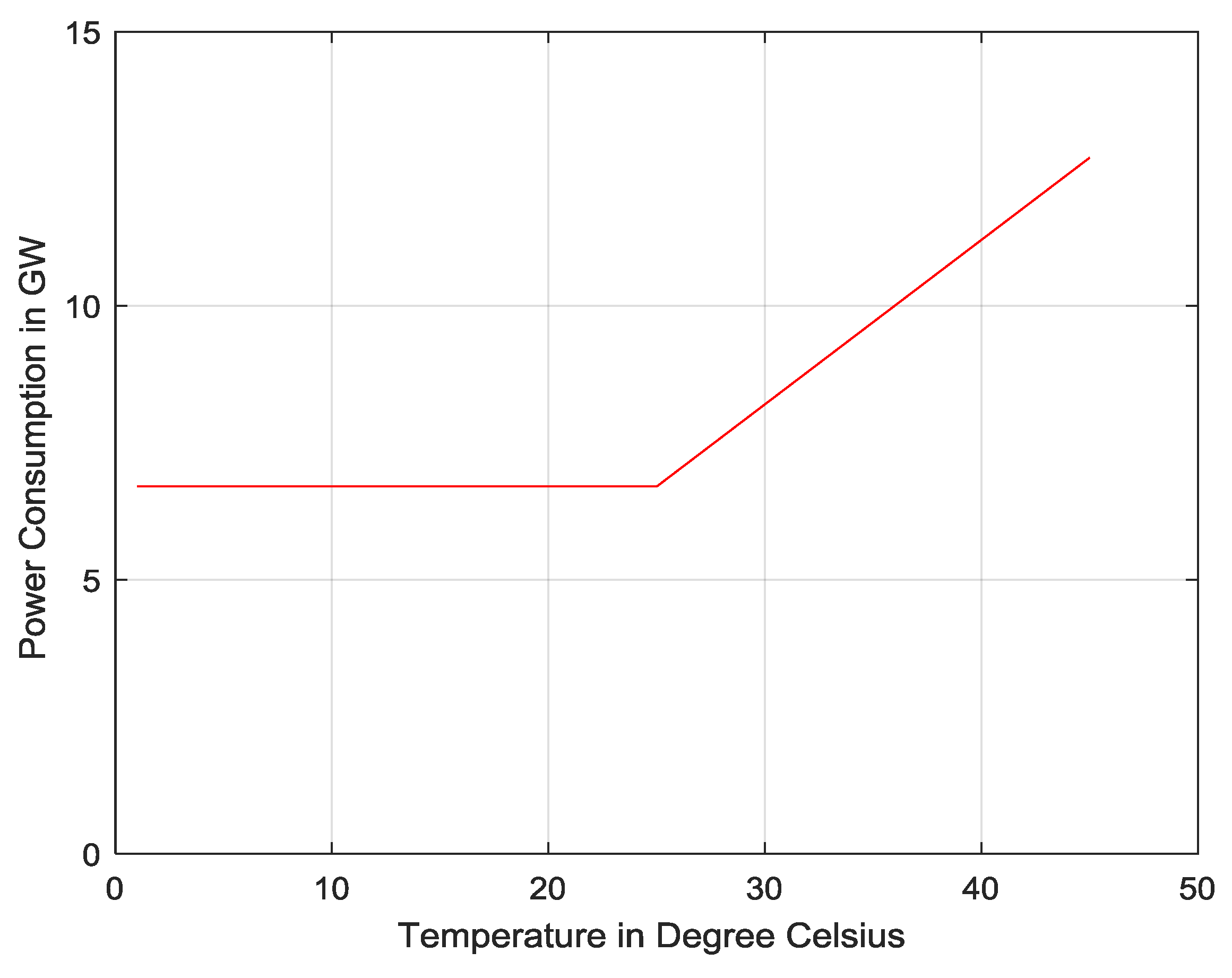
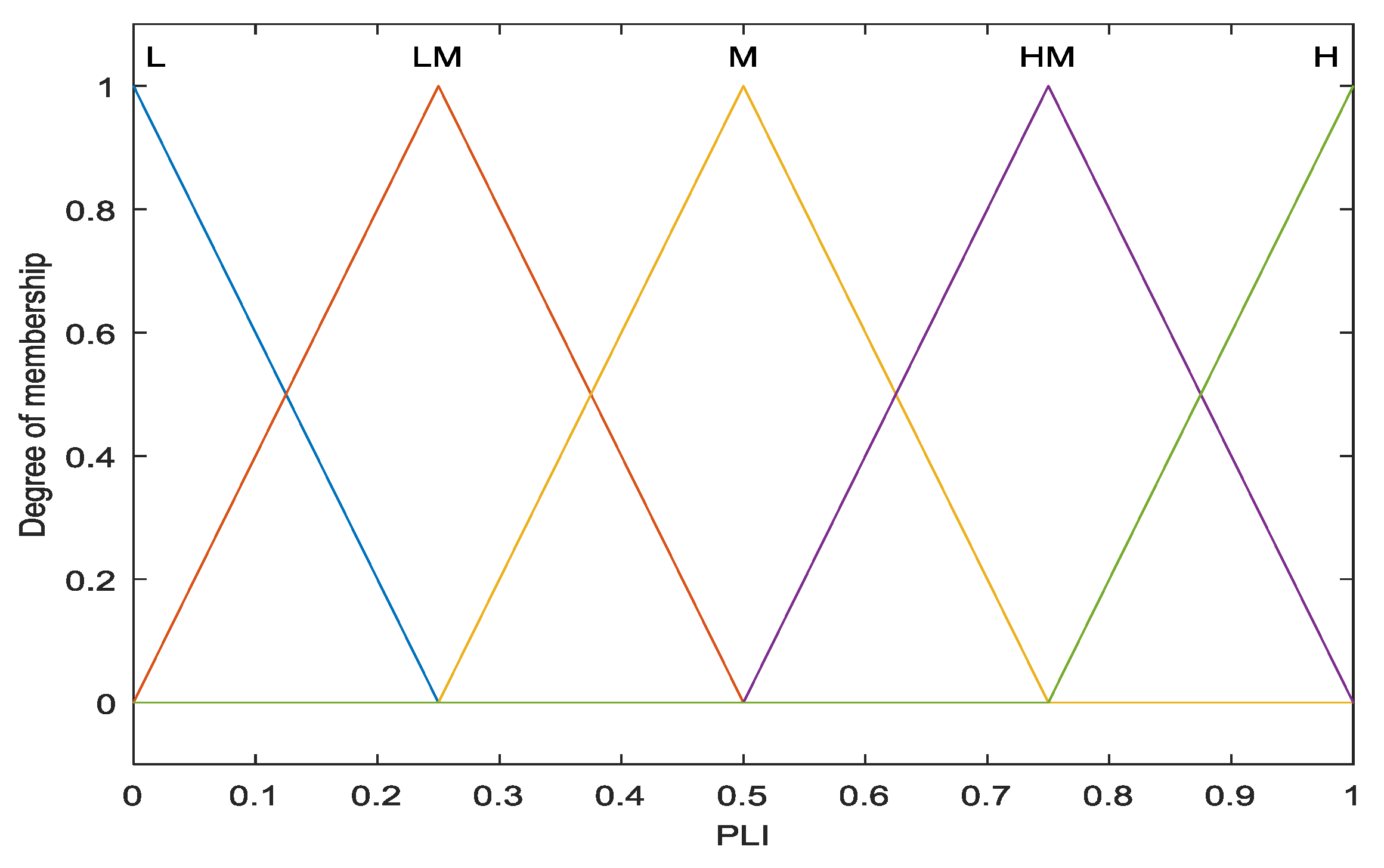
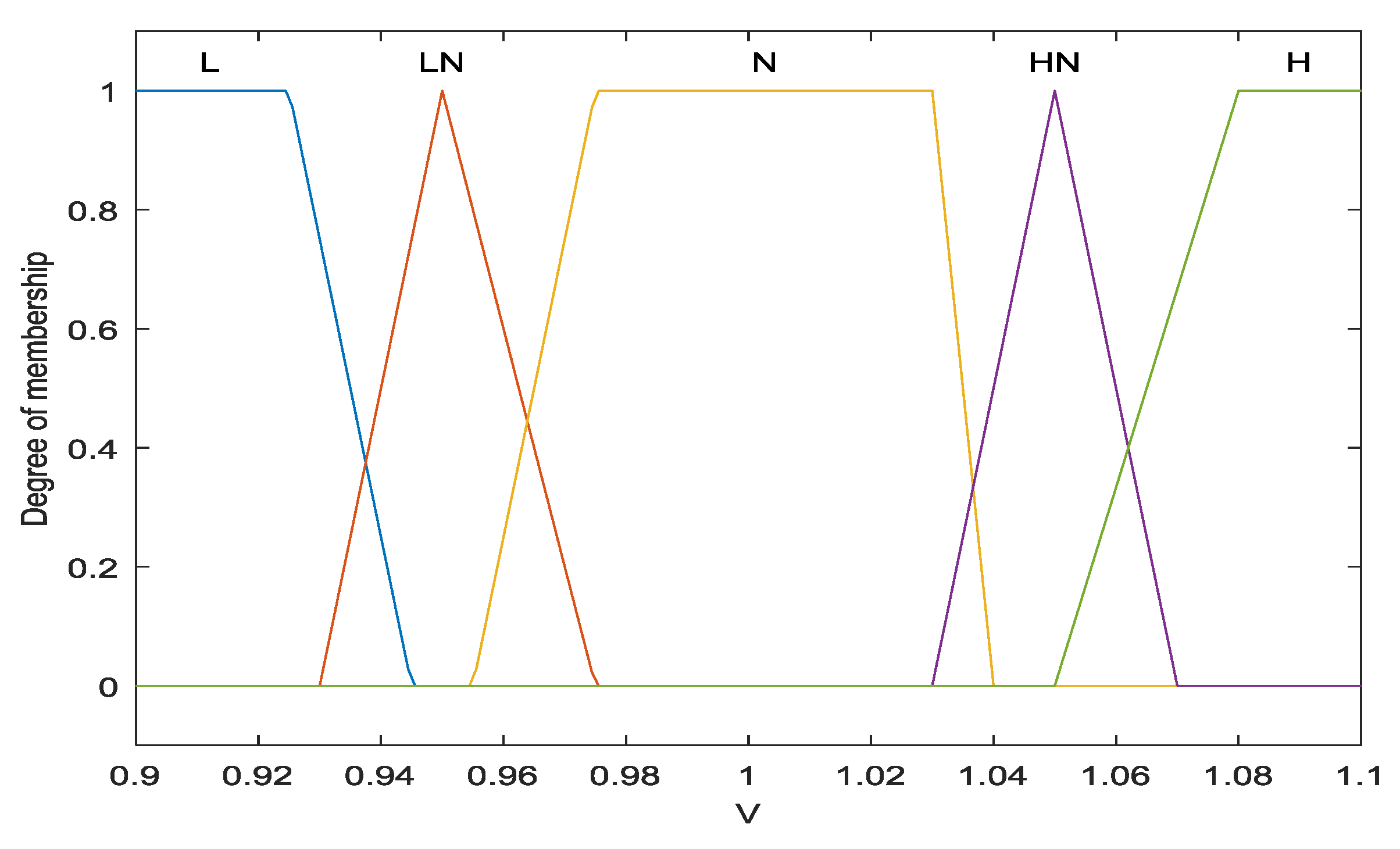

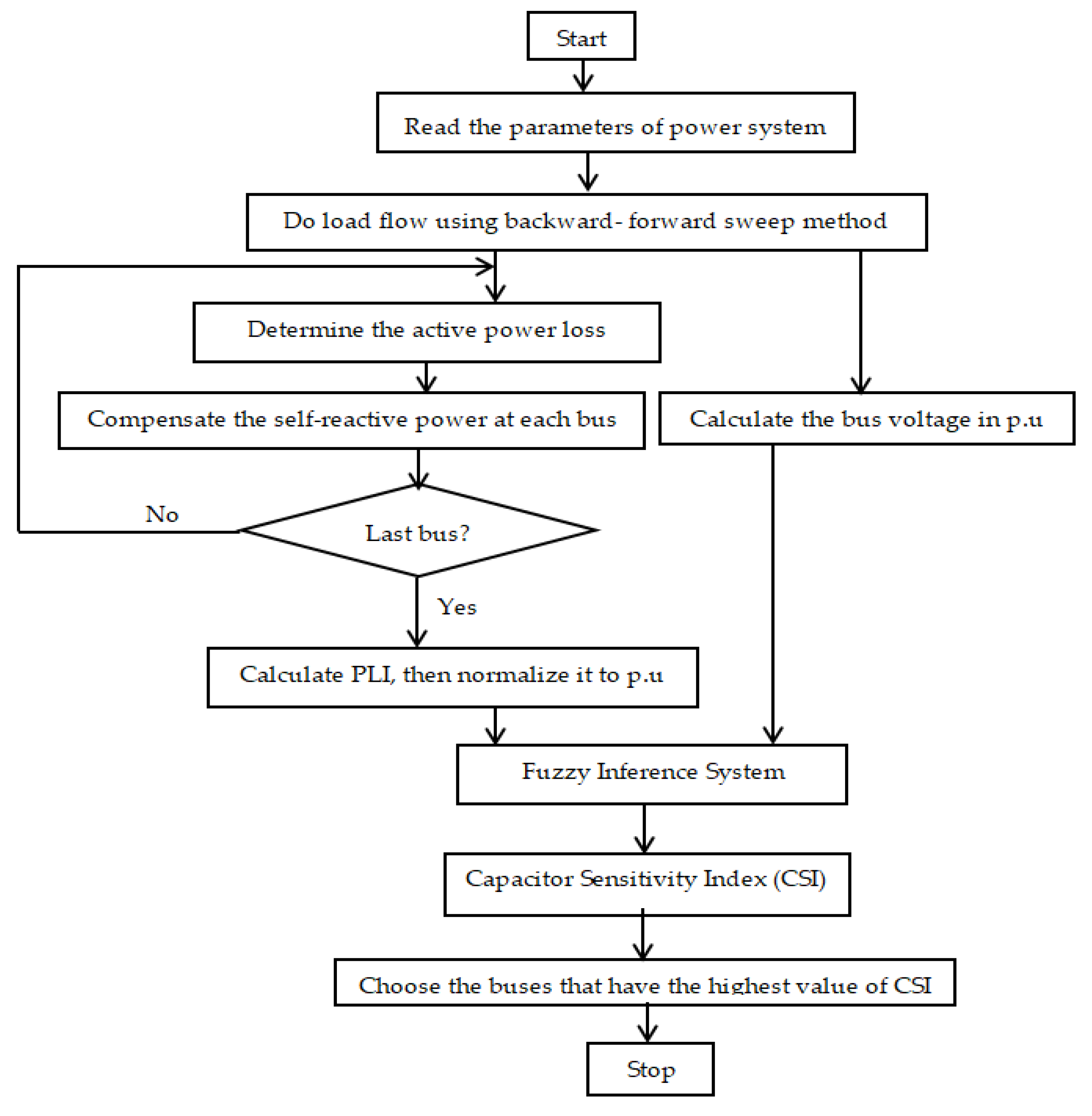
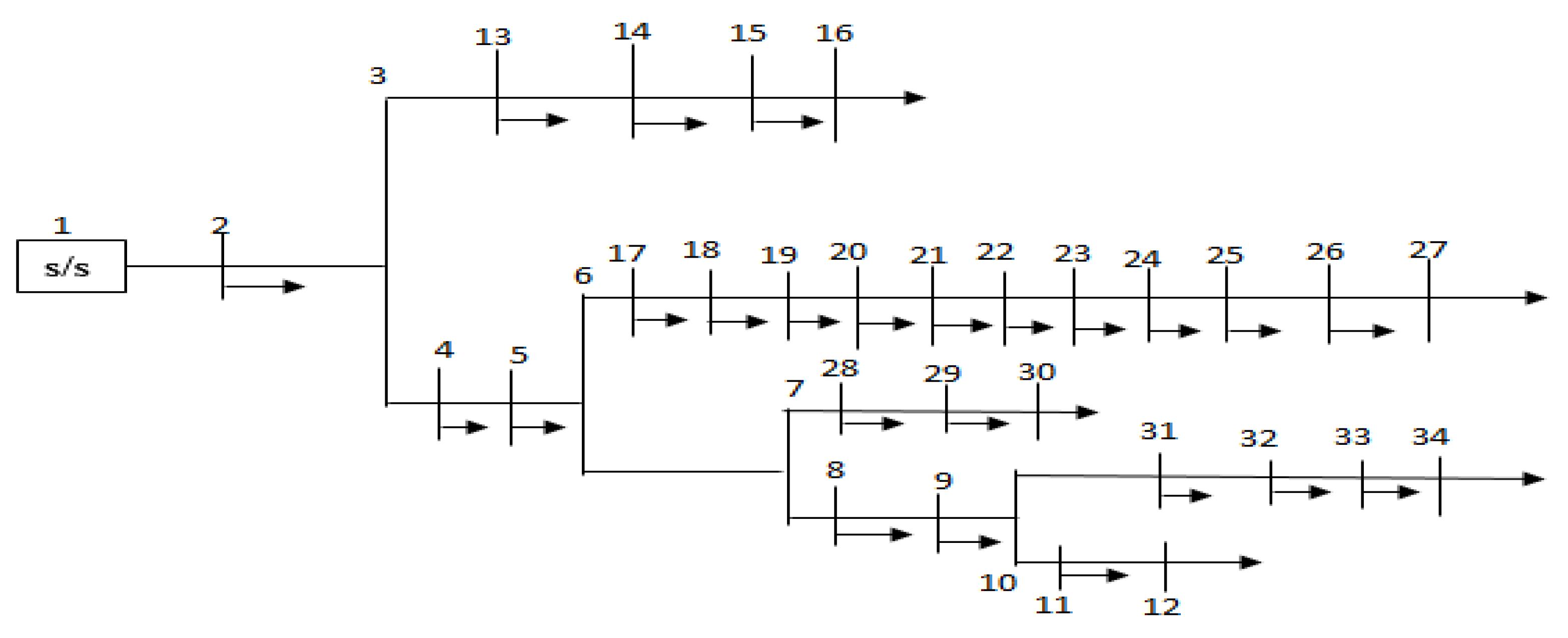

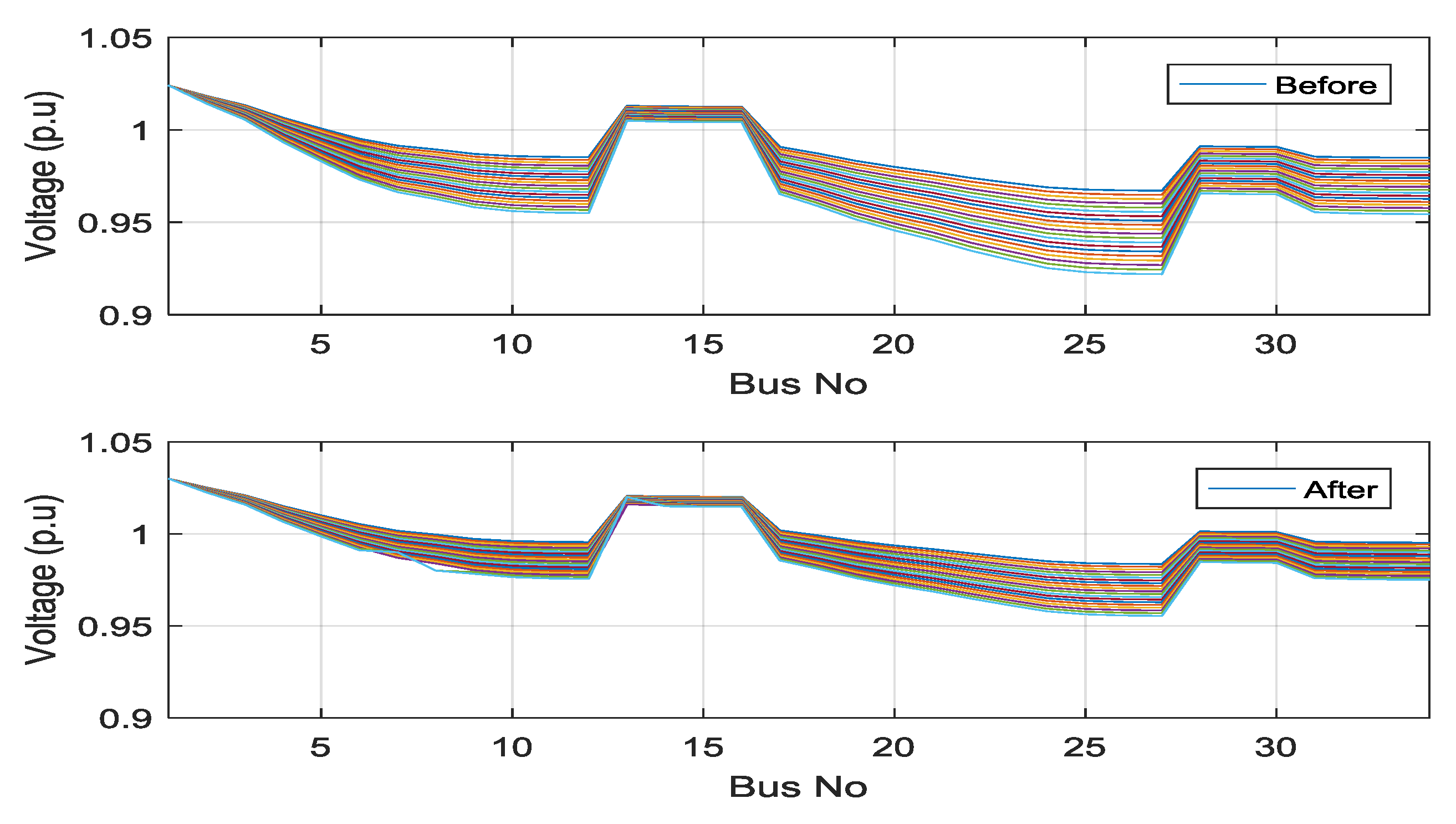
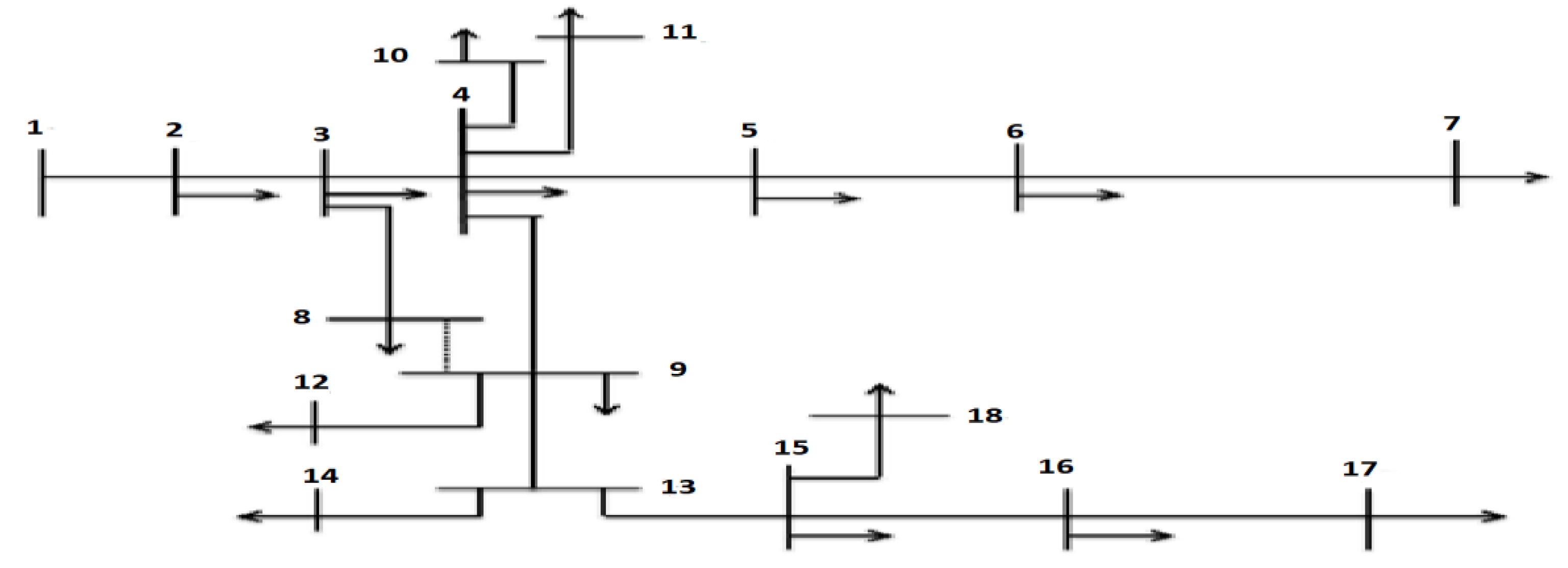
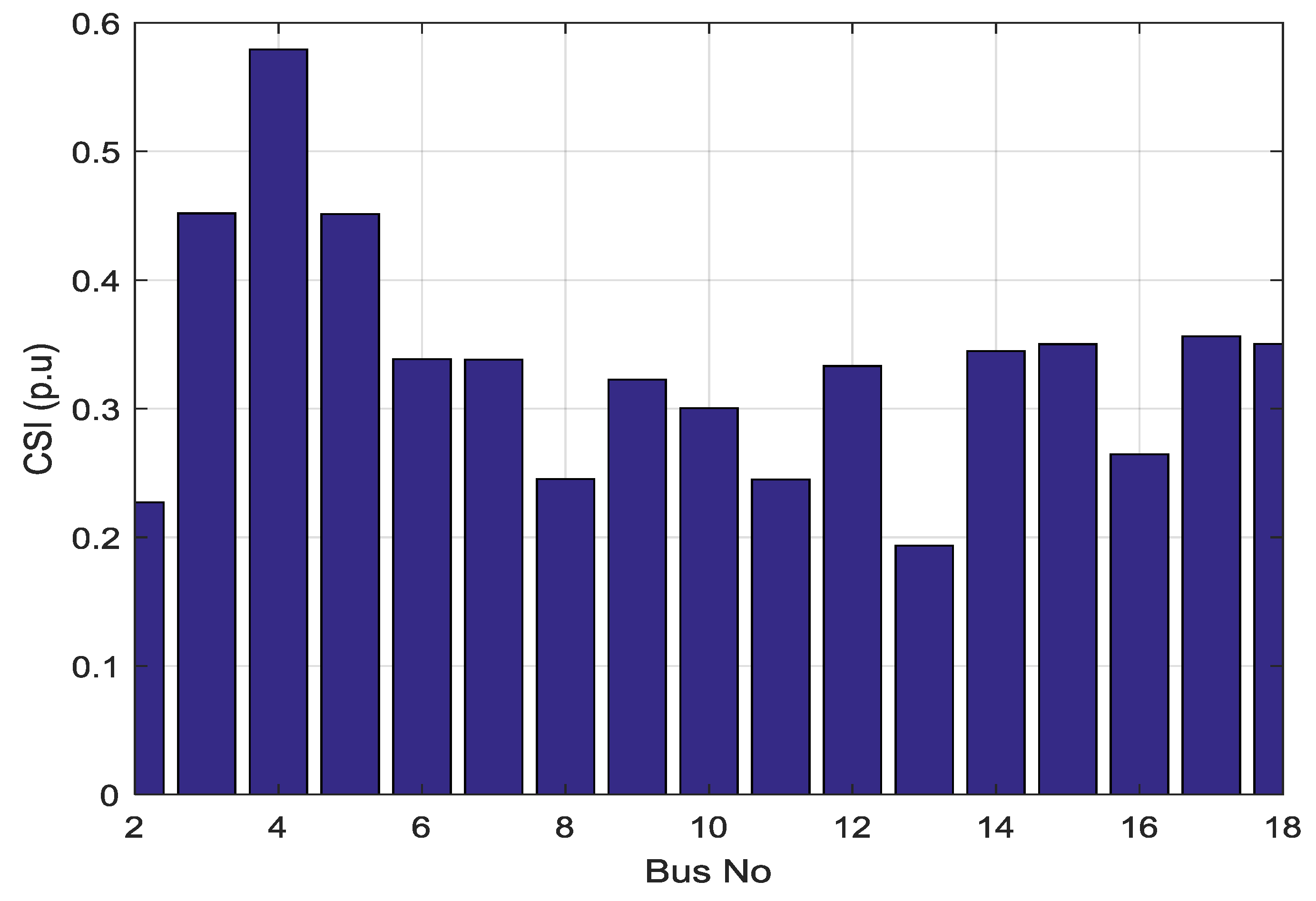
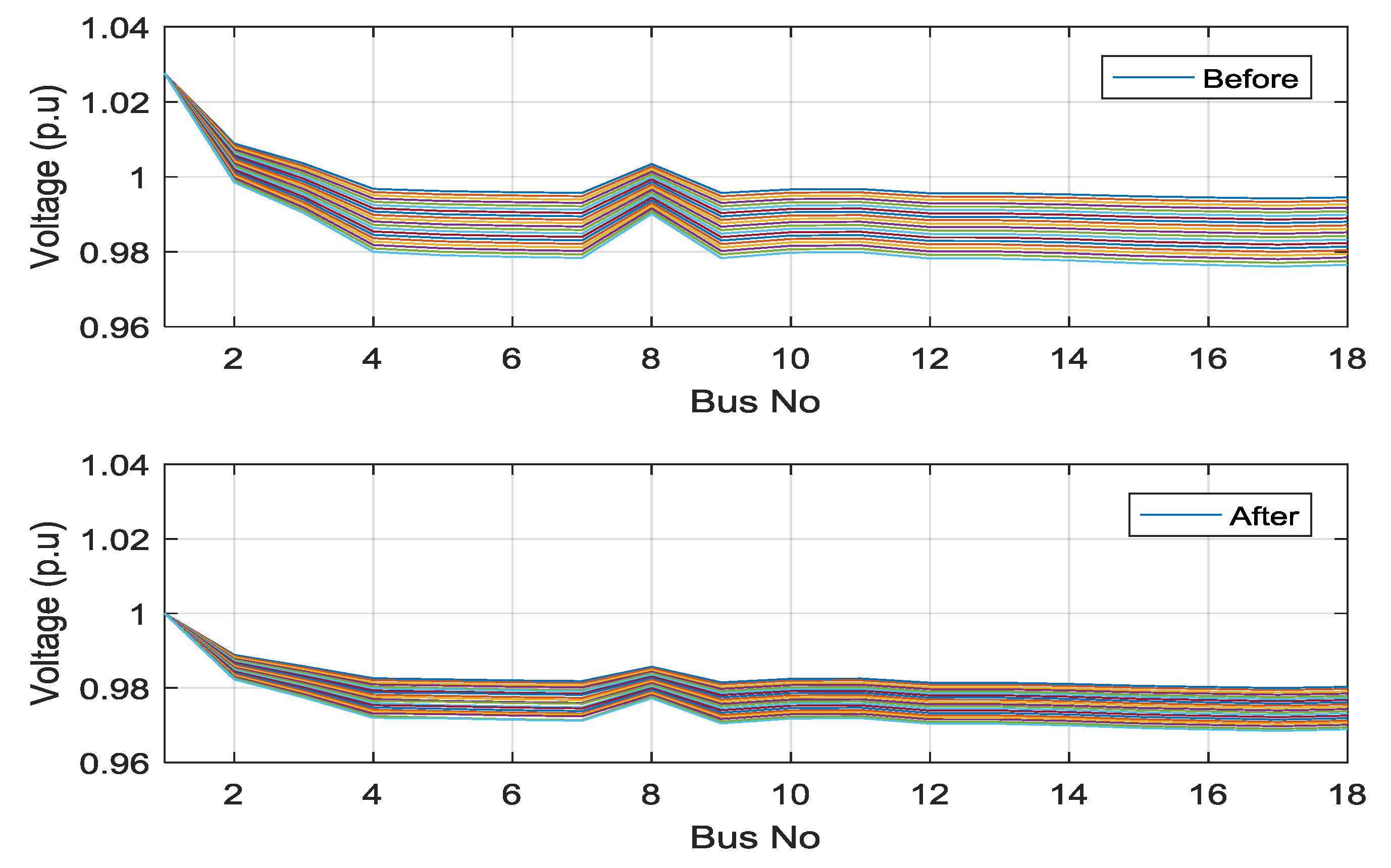
| CSI | V | |||||
|---|---|---|---|---|---|---|
| L | LM | M | HM | H | ||
| PLI | L | LM | LM | L | L | L |
| LM | M | LM | LM | L | L | |
| M | HM | M | LM | L | L | |
| HM | HM | HM | M | LM | L | |
| H | H | HM | M | LM | LM | |
| Bus No | BCP (MVAR) | Proposed (MVAR) |
|---|---|---|
| 26 | 0 | 0.320 |
| 24 | 0 | 0.190 |
| 23 | 0 | 0.190 |
| 25 | 0 | 0.200 |
| 22 | 0 | 1.200 |
| Total MVAR | 0 | 2.100 |
| Max. voltage (p.u) | 1.02 | 1.03 |
| Min. voltage (p.u) | 0.9219 | 0.9554 |
| Max. THD | 9.37 | 5 |
| Power losses (kW) | 515.14 | 320.69 |
| Reduction (%) | 0 | 36.15 |
| Capacitor cost ($/year) | 0 | 2550 |
| Power loss reduction cost ($/year) | 61,817 | 23,334 |
| Energy loss reduction cost ($/year) | 56,408 | 21,292 |
| Benefit ($/year) | 0 | 42,080 |
| Benefit–cost ratio | 0 | 16.5 |
| Bus No | BCP (MVAR) | Proposed (MVAR) |
|---|---|---|
| 4 | 0 | 0.700 |
| 3 | 0 | 0.110 |
| 5 | 0 | 0.430 |
| Total MVAR | 0 | 1.240 |
| Max. voltage (p.u) | 1.03 | 1 |
| Min. voltage (p.u) | 0.9761 | 0.9685 |
| Max. THD | 8.76 | 4.2 |
| Power losses (kW) | 137.49 | 87.46 |
| Reduction (%) | 0 | 34.35 |
| Capacitor cost ($/year) | 0 | 1350 |
| Power loss reduction cost ($/year) | 16,500 | 6000 |
| Energy loss reduction cost ($/year) | 15,055 | 5478 |
| Benefit ($/year) | 0 | 10,128 |
| Benefit–cost ratio | 0 | 7.5 |
© 2018 by the authors. Licensee MDPI, Basel, Switzerland. This article is an open access article distributed under the terms and conditions of the Creative Commons Attribution (CC BY) license (http://creativecommons.org/licenses/by/4.0/).
Share and Cite
Al-Ammar, E.A.; Ghazi, G.A.; Ko, W. Impact of Ambient Temperature on Shunt Capacitor Placement in a Distorted Radial Distribution System. Energies 2018, 11, 1585. https://doi.org/10.3390/en11061585
Al-Ammar EA, Ghazi GA, Ko W. Impact of Ambient Temperature on Shunt Capacitor Placement in a Distorted Radial Distribution System. Energies. 2018; 11(6):1585. https://doi.org/10.3390/en11061585
Chicago/Turabian StyleAl-Ammar, Essam A., Ghazi A. Ghazi, and Wonsuk Ko. 2018. "Impact of Ambient Temperature on Shunt Capacitor Placement in a Distorted Radial Distribution System" Energies 11, no. 6: 1585. https://doi.org/10.3390/en11061585
APA StyleAl-Ammar, E. A., Ghazi, G. A., & Ko, W. (2018). Impact of Ambient Temperature on Shunt Capacitor Placement in a Distorted Radial Distribution System. Energies, 11(6), 1585. https://doi.org/10.3390/en11061585







